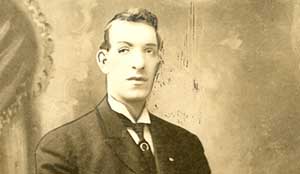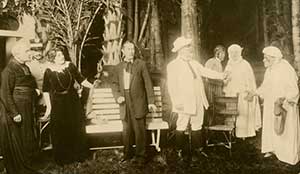J. Willis Sayre Collection of Theatrical Photographs
The Sayre Collection consists of more than 24,000 photographs of theatrical and vaudeville performers, musicians, and entertainers who played in Seattle between about 1900 and 1955 (some of the materials date back to the 1870s). The collector was J. Willis Sayre: drama critic, journalist, promoter. The collection covers the little-studied period when Seattle had a prominent place in the development of vaudeville between 1905 and 1914. John Cort, Sullivan, and Considine and Alexander Pantages all operated out of Seattle and the Sayre Collection includes not only the publicity photographs from New York photographers, but also hundreds done in Seattle, Portland, and San Francisco.
Thanks to a generous grant from the National Historical Publications and Records Commission (NHPRC), the UW Libraries recently completed a comprehensive re-digitization of all the images in this collection. The original images, digitized in 1987, were very small and of poor quality due to the absence of digitization best-practices at that time. We are more than pleased to have been given the opportunity to vastly improve the experience of the viewer. The result is that viewing the images online is now much more informative and pleasant.
Background
James Willis Sayre, born in 1877, was one of the most influential figures in conserving and writing about theater and dance in Seattle. His connection with Seattle theatrical enterprises commenced about 1891 when he found a job folding programs at the Seattle Opera House. Later he worked for the Seattle Theatre during the administration of John W. Hanna. In 1899 Sayre joined the John Cort organization and soon opened the first theatrical advertising agency in Seattle.
Between 1889 and the 1930's Sayre was publicity man for virtually every Seattle theater of consequence; the Grand Opera House, the Seattle Theatre, the Lyceum, the Palm Garden, the Second Avenue Orpheum, the Star, the Alhambra, the Majestic, the Mission, Liberty, Fifth Avenue, Coliseum, Rex, Strand, Pantages, Music and the Blue Mouse. Most of these were legitimate houses before the advent of movies, and some booked both live and film productions afterwards. Sayre knew everybody who was anybody, and even more people who were nobodies but who knew him because of his colorful activities as dandy, bon vivant, critic, reviewer, and agent for the beautiful people from Broadway and Hollywood. For twenty years he wrote for the three local newspapers and the several local magazines which reported activities in the city's numerous entertainment centers. Sayre, it appears, covered them all.
Within Sayre's vast private collection of theatre and dance memorabilia he compiled both a descriptive and graphic chronicle of Seattle theatrical history that he had personally witnessed. He also wrote on the history of Seattle, on the origin of its streets and their names, on its early theatres and also (it is said) wrote several full length plays, vaudeville sketches and movie scenarios. For a time he was manager of the Seattle Symphony Orchestra too.
Another Seattle personality and impresario, Ivar Haglund, was a personal friend of Sayre's in his last years and recalls him as a great conversationalist and raconteur with many stories about theatre people, and the habitues of the better steak and chop houses. He dressed well and wore spats, Haglund recalls. "He never wrote an unfavorable review", Haglund claims, although he is known to have ignored mentioning a performer who had disappointed him. He also is said to have hated Italian tenors who pandered to the audience by singing Mother Macree. Seemingly, his own dual role of the theatre agent and media reviewer, if he was in fact both, presented no conflict of interest, but may have compelled him to view the performances of some with more courtesy than candor.
According to the Town Crier, Sayre was the busiest man in town in 1914. He reviewed three plays or shows a day, saw a movie, heard part of a recital, watched the finale of a musical, and then interviewed a star in her dressing room. He assiduously collected theatre programs and publicity stills of the great and near great and was never known to have returned an unused one however urgent the plea from an actor. The Town Crier estimated that Sayre owned more autographed portraits of actors, actresses, child performers, singers, dancers, musicians, comedians and acrobats than any other man in the United States. Some claimed that through a deft manipulation of his dated autographed portraits, Sayre could triangulate the exact age of any actress of any prominence and tell precisely when she commenced her career playing Little Eva and old she was at the time. An ordinary man would have burned himself out far earlier than Sayre did. Never a conventional man, Sayre lived to be 86 and died in his prime.
A major portion of the publicity stills, autographed studio portraits and theater program collection that J. Willis Sayre amassed from the 1890s onward represents one the great resources in American theater history research. The original images are housed in the UW Libraries Special Collections Division. (Written by Robert Monroe)
About the Database
The information for the J. Willis Sayre Collection was researched and prepared by the UW Libraries Special Collections Division staff. The original collection resides in the UW Libraries Special Collections Division as the J. Willis Sayre Photograph Collection PH Coll 200.
Early photographic techniques
The Sayre photograph collection contains several examples of photographic techniques such as:




